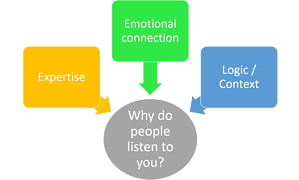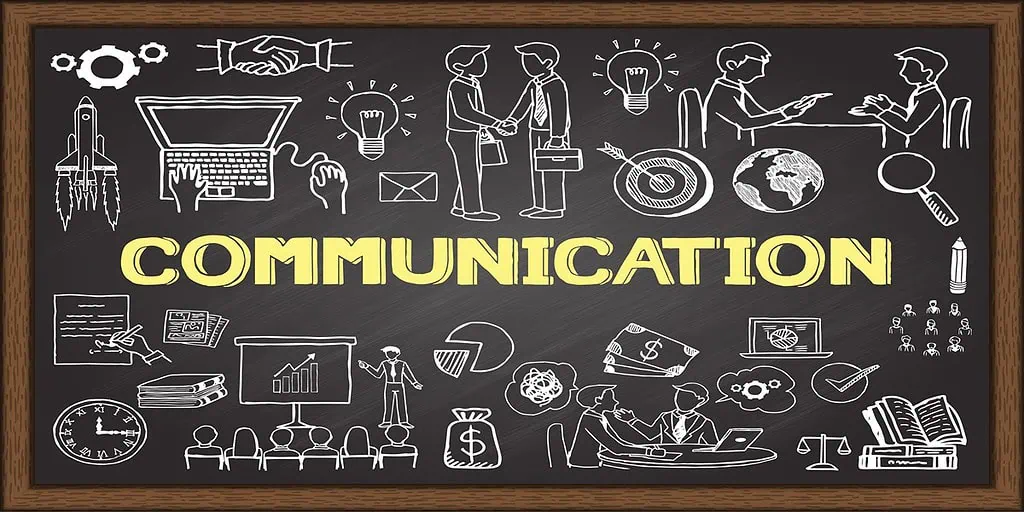Article Contents:
Most interpersonal problems in personal and professional life stem from ineffective communication. Analysis of people-related issues in the workplace often reveals poor communication as a root cause, whether due to a lack of expression, information, or misinterpretation.
Effective individuals typically possess excellent communication skills and continuously strive to improve them. Developing communication skills is a lifelong endeavor, and no one can claim to be the best communicator.
Regardless of your current level of communication effectiveness, communication skills can be improved over time with awareness and effort.
Many people mistakenly believe that communication skills are solely about language proficiency.
In my opinion, effective communication results from effective emotional management, clarity of thought, and mastery of language.
Effective communication involves managing emotions, clear thinking, and articulation.
Let us discuss some insights for improving workplace communication on the following aspects:
- Taking responsibility for your communication
- Managing your emotions and body language
- Adapting your communication style to others
- Managing conflict and maintaining relationships
- Transitioning from commanding to influencing in the workplace
- Creating an environment for better communication.
Communication effectiveness starts from owning responsibility
Effective communication is not about how much or what you are communicating to others, but rather how well your purpose of communication is met.
For instance, if you are instructing your colleague to complete a task in a specific manner, the communication can only be considered effective if your colleague understands the intention of your communication and completes the task accordingly.
Taking responsibility for Communication Effectiveness:
Our general tendency is to blame others for their misunderstanding or incapability when the task is not completed as per our intended communication.
The first step in improving your communication skills is to accept responsibility for your communication process.
It’s not that others misunderstand your communication, but rather that you have not yet mastered the communication skill to adapt your communication process based on others.
Since each individual is different due to background and exposure, there is always a chance for misinterpretation.
Mastering the communication process involves customizing your communication style to suit different people and environments.
For example, as a business head, if you can communicate your organization’s goal to your second-level management team and the operating team in a way that they understand and emotionally connect with the organization, then you are an effective communicator.
This requires effort in mastering the communication process, and that responsibility lies with you.
The point is that each one of us has the potential to improve the communication process, and first, we need to take responsibility for effective communication rather than pointing fingers at others.
When you take ownership, you are open to learning and experimenting with communication processes and techniques.
Let’s delve further into the communication Effectiveness process and techniques!
When will people listen to you?
People often say, “My team is not doing what I am asking them to do.”
This concern is often more related to our communication process than to the attitude and capability of other people.
Effective communication requires the following elements for people to listen to us:
- Expertise in the subject or proof of credibility
- Emotional connection with the person
- Logical connection with facts
Let’s discuss each element in detail.

Expertise in the subject or credibility proof:
We tend to give more importance to the person speaking rather than what is being said. If others believe that you have expertise in the subject, there is a higher chance of active listening and, in turn, execution as per communication.
We need to make others believe that we are the right person to talk about the subject.
For example, as an accounts manager, if you instruct your team about using accounting software, people are internally checking your expertise on the software. If they feel you do not have sufficient knowledge about the software, their active listening will decrease.
In most organizations, newcomers face the challenge of gaining their team’s confidence, as the team may have suspicions about the newcomer’s expertise.
It is the prime responsibility of the newcomer to prove their technical/managerial expertise to win the confidence of the team.
People may respect you for your age or position. However, their minds are working to gauge your expertise, and accordingly, they receive the intent of communication.
Therefore, you need to invest your time and effort in developing competence in your core area to improve communication effectiveness.
Communication Effectiveness: connecting with others
What does it mean to connect with someone emotionally?
It involves preparing yourself and the other person to be comfortable before and during an interaction.
When both parties are comfortable, there is less chance of misinterpreting the communication.
Several factors contribute to creating a comfortable zone:
- Showing respect and making others feel valued
- Using friendly body language
- Giving undivided attention
- Actively listening and providing feedback
- Addressing the question of “what’s in it for me”
However, it’s important to recognize that not everyone can deeply listen during an interaction due to internal emotions such as fear, curiosity, or anxiety.
When these emotions are present, listening ability diminishes, leading to misinterpretation.
Even if you excel in subject expertise and logical thinking, without the ability to connect with others, your communication will fail.
Therefore, it’s crucial to help others feel comfortable during interactions by using the aforementioned factors.
How can you display respect for others?
There are many ways you can show respect to another person;
one of the most powerful methods is to make another person feel good in your presence through your gestures.
How you treat another person will make them feel good about themselves, and their listening ability improves when you interact with them.
I had an experience with another person’s gesture and my self-esteem some years back.
My colleague and I went to our HR manager to discuss some people-related issues. Before the meeting, we checked his availability. When we entered his room, he was busy on his laptop and did not ask us to sit. Despite that, we sat for more than 10 minutes, and he did not have the courtesy to ask us to wait by stating his urgent work. In between his typing, he instructed us regarding the people issues, and we were not in a position to listen. After a while, we left. Throughout the entire process, he never looked at us, and we felt bad about it.
We understood his urgency, but we expected that he could have requested us to wait for a few minutes. Once he finished the task on the laptop, he could have closed it and given us his undivided attention. Those small gestures might have made us feel good.
It is natural to neglect others due to urgent work, but it does not matter to the other person. It is essential how another person is feeling in your presence. It seems like common sense and a soft aspect, but it makes a big difference in other people’s minds. If you do not make another person feel good, you are not preparing them for your subsequent communication.
If you are rude, always reacting, and unappreciative, then people may not feel self-esteemed in your presence.
When people do not feel good enough in your presence, their listening ability also reduces.
Hence, first, make the other person feel good with you by showing respect through your gestures.
Just be aware of your gestures as we need to evolve as good human beings.
Awareness of body language and state of mind:
Let’s consider the importance of body language in communication. Whether in face-to-face or phone conversations, our posture, tone, eye contact, and facial expressions all play a role in how we communicate before we even start talking. This is what we call body language.
Your body language reflects your state of mind at any given moment.
If you’re feeling happy and enthusiastic, your body language will likely be positive and pleasing to others.
Conversely, if you’re feeling angry, fearful, sad, or anxious, your body language will reflect that and negatively impact the quality of communication.
The good news is that your state of mind and body language are interconnected, and you can change one by changing the other.
For instance, if you’re feeling dull and sitting with a slouched posture, simply standing up, stretching, and taking a deep breath can help you feel more relaxed and positive.
The key takeaway is that you can influence your state of mind by adjusting your body language, and it’s important to be mindful of this when communicating with others.
Giving undivided attention:

Having discussed the importance of making other people feel good in your presence and the impact of body language on active listening, let’s consider other factors that affect the emotional aspects of communication, such as giving undivided attention during a conversation.
Undivided attention:
Whether you are speaking to someone or someone is speaking to you, the level of care you give to the conversation without any other distractions is what undivided attention is all about.
You may have encountered a situation where you are conveying something to your colleagues or someone, and they might be looking at their mobile, laptop, or looking around at someone or waving their hands to someone, rather than listening to your message. That is an example of divided attention.
When you experience this, you may either lose energy, or the other person receives only half the information. Either way, the effectiveness is lost.
Undivided attention can be demonstrated through eye contact with the other person, prompting the other person, or nodding your head when you listen to another person.
Even though it may seem like common courtesy, it is difficult for everyone to follow. Hence, this is an art or skill that needs to be mastered with awareness and practice.
This skill is particularly important when you interact on a one-to-one basis with others.
Giving undivided attention is a conscious effort and can be developed with awareness and practice.
Setting the Context for effective communication:
One common pitfall in ineffective communication is the lack of clarity regarding the context or background.
Assumptions can significantly distort the intention of communication. As a leader, it’s important to spend more time clearly setting the context when communicating critical instructions or tasks to others.
For example, some years ago, my manager asked me to prepare a plant layout design to accommodate additional facilities. I delved into data collection and detailed design options. A week later, he asked to see the proposal, and I informed him that I was still collecting data. He became annoyed with my response.
He then clarified that he initially wanted a quick conceptual layout for feasibility purposes to obtain management approval, while I was working on the detailed, micro-level plan, which was supposed to be done once the concept was approved. This resulted in a loss of time.
The lesson here is the “mismatch of assumptions” by both parties.
Effective communication would have required the manager to communicate the purpose behind his request for layout options, the phases he wanted to go through, and a specific timeline. This is the importance of context setting.
When the context is not set clearly, people will make assumptions based on their knowledge and background, leading to a loss of communication intent.
While it’s true that the receiver should also clarify assumptions, in reality, the giver usually has more knowledge and should set the context.
Therefore, to improve the communication effectiveness, the context must be clearly articulated without leaving room for assumptions.
Setting the context as part of the conversation becomes a habit when practiced consciously.
Criticism - a barrier for effective communication
One of the barriers to effective communication is “criticism.”
When criticism occurs, either the sender or receiver can shut down the communication flow.
What is meant by criticism?
Criticism is our judgment about someone or somebody’s activities and is expressed more aggressively.
For example
In one organization, a senior design manager found a mistake in his subordinate’s design work. He called the person and shouted, “You are a useless designer. You do not know the design fundamentals. You are simply wasting my time.”
In reality, the manager only recruited a junior designer.
In another organization, the business head rolled out a new initiative to his team and said, “You people are never going to take it forward, as I know you failed in the past with similar initiatives.”
Both examples involve harsh words that attack the person and do not provide any direction for improvement.
This is a characteristic of criticism.
Why do we criticize others?
We may judge others with good intentions, such as wanting them to improve, caring for their growth, disliking the way things are being done, or having an inherent nature of finding perfection in everything or only seeing a black dot in an entire white space.
Whether we criticize others knowingly or unknowingly, our words and expressions hurt others.
Criticism affects others by lowering their self-image or confidence in their process.
Criticism Vs. Feedback
In a professional setting, it’s important to consider alternatives to criticism.
When we criticize others, even with the intention of providing correction, the recipient may take it personally and become defensive. This can lead to arguments, feelings of inferiority, or even personal vendettas.
However, as a leader, it’s crucial to address mistakes and behaviors without resorting to judgment or criticism.
One effective alternative to criticism is providing feedback.
It’s important to understand the distinction between criticism and feedback.
Criticism tends to involve judgment, targeting the individual, and can be harsh in its expression. It often focuses on past actions.
On the other hand, feedback involves evaluating the process, targeting specific behaviors, and providing constructive solutions for the future.
For instance,
if a team member makes mistakes in a presentation, as a leader, you have two choices in how to respond.
If you choose to criticize, your response might sound like, “You always make mistakes in your presentation. You don’t seem to understand the basics of proofreading.”
On the other hand, if you opt for feedback, your response might be, “I noticed several errors in your presentation. I recommend using the spell check option to catch these errors before sharing it with others. Let me know if you need help learning how to use it.”
Both approaches address the mistakes and aim to correct the behavior, but feedback focuses on providing value and guidance rather than judgment.
Responding to Feedback:
As we discussed earlier, there is a fine line between criticism and feedback when it comes to improving communication effectiveness in a professional setting.
However, there are other aspects to consider when it comes to improving feedback effectiveness.
As the sender of feedback, it’s important to ensure that the receiver takes the feedback in the right perspective for it to be effective.
How one responds to feedback directly impacts the quality of communication between the two parties involved.
For instance,
when your boss or colleague points out a gap in your behavior or performance, your response will determine the quality of communication between you and the other person.
Here are some possible responses and their potential consequences:

- Taking it too personally:
Feeling guilty and becoming upset about the feedback can result in a decrease in self-esteem and hinder any progress in performance improvement.
- Defending the feedback giver:
Justifying your position to the feedback giver may win you the argument, but it can also prevent you from acknowledging the truth in the feedback, leading to no progress in performance improvement.
- Analyzing the feedback with a rational approach:
Listening to the feedback and seeking further clarity, while introspecting and analyzing the situation, can help you accept the need for corrective action and ultimately lead to growth.
The key point here is that the choice of response to feedback plays a crucial role in determining the quality of communication and progress.
It’s important to be mindful of how you respond to feedback when you are the receiver.
Managing Conflict:
Conflict in the workplace refers to a difference in thought process, interests, or opinions among individuals or teams.
For example,
conflict may arise when senior management aims to increase top-line growth, while newer executives prioritize maximizing profitability over sales growth.
Another example could be maintenance team members requesting the release of machines for maintenance purposes, while the production team refuses to do so in order to meet delivery targets.
Conflicts occur in the workplace due to differences in background, exposure, functional priorities, agendas, or lack of awareness about tasks or outcomes.
Disagreements can also arise due to positional status or individual egos.
If conflicts are not managed well, they can lead to damaged relationships, internal stress, prolonged decision-making, and an environment that is not conducive to harmony.
It’s important to learn different strategies to manage conflicts effectively.
Let’s discuss conflict management methods and effective communication methods.
Managing conflict with elevated thinking:
When conflict happens between two people in the workplace, they often use the following methods to resolve the conflict:
- Forcing others to accept your views with your positional power
- Passively accepting other views without expressing your standpoint
- Ignoring and moving on
- Compromising – settling down in between which way both are not happy
- Collaborating to find the intention behind others’ view and finding the solution which is mutually agreed upon happily.
Each method has its implications on the relationship and the quality of work.
One of the ways effective leaders adopt to deal with conflict is “working on elevation.”
For example,
when conflict happens between functions, such as finance and marketing on delivering the goods against payment only, the conflict resolution could be going along with the opinion of finance or marketing.
The effective leader solves the conflict by bringing the customer or organizational wellness into the perspective to resolve the conflict among the functions.
Similarly, in most workplaces, the conflict between two people would be “who is supposed to do what,” and the conflict gets into personal friction among the individuals.
Even though this can be claimed as an organizational development issue, the conflict can be avoided if either one of them thinks from the third angle of the customer or organization’s perspective.
When you think or look at higher needs, the low-level conflict can be resolved.
This is one of the leadership qualities in dealing with conflicts.
Let us discuss the communication process in dealing with conflicts.
Managing conflict with the communication process:
As we discussed, conflict in the workplace is inevitable due to different viewpoints, but it can be managed to get things done and maintain a positive relationship.
Regardless of the conflict, how we approach it through effective communication makes a difference.
This is more of a state of mind and a skill that needs to be learned.
Before delving into different communication processes, it’s important to clarify which conflicts are worth addressing and which ones are better to let go of.
Practical approaches for dealing with conflict are as follows, and each one has its merits depending on the nature of the conflict, the people involved, and the situation:
- Passively expressing
- Aggressively expressing
- Assertively expressing
Now, let’s understand the insights into each of these communication processes.
Passively expressing:
When a conflict occurs between two people, one person takes a passive approach by allowing the other person to satisfy their concerns while neglecting their own. Internally, the person is suffering in this process.
This approach can be beneficial when the other person is being “power-centered” and is not willing to listen to your views. It can also be useful when you do not want to engage in the conflict or if the conflict is not worth pursuing.
For example,
if the conflict is about scheduling review meetings in the morning or afternoon with your boss, there is no point in debating or justifying your preference for morning or evening.
In either case, you are the essential person in the review meeting. Arguing about this issue would be a waste of energy, and it’s better to take a passive approach.
Depending on the importance of the issue, you need to weigh relationships versus tasks and then decide whether to ignore it or go with the flow.
However, you need to be mindful of your inner peace when conflicts arise and how you choose to deal with them through passive expression.
Aggressively expressing:
When a difference of opinion or conflict arises between two people or teams, one person may assert dominance and compel the others to accept their views and move forward.
This type of communication is known as aggressive communication.
Is aggressive communication right or wrong?
Only the context can define it.
Generally, it is believed that aggressiveness is not the right way of communication.
However, in a workplace setting, there are times when decisions must be made promptly and timing is critical.
In such situations, the person in an authoritative position may need to assertively communicate to guide the conversation towards a decision.
When someone adopts an aggressive approach for a higher purpose, it can be considered acceptable, as opposed to avoiding making any decision altogether.
In some organizations I have observed, people are considerate towards each other in all matters, and as a result, no decisions are reached because they perceive aggressiveness as disruptive to harmony.
When is aggressiveness perceived as rude or bad? Naturally, when one seeks to force others to accept their views, their body language shifts from compassionate to commanding, their tone becomes more forceful, and they may lose emotional balance.
This can lead to delving into personal matters, bringing up past references, or discussing irrelevant topics.
During these moments, the individual may be seen as an “angry, emotionally unstable person,” and the intended message gets lost.
There is a fine line between assertive and aggressive expression of views, and this can be discerned through awareness.
Let’s now discuss assertive expression.
Managing conflict with assertive communication
When conflict occurs in the workplace, you have a choice to manage it through either passive or aggressive means, and both have pros and cons.
The third choice to manage conflict is assertive communication, which has only advantages.
This communication quality helps to improve the harmony and growth of the individual.
However, it requires managing your emotions during the conflict and a high level of patience and maturity. If one puts effort into learning this skill in life, I can say that it is the most precious asset one can have.
Assertive communication:
Assertive communication is all about expressing your views while maintaining respect, showing empathy, and understanding others’ opinions from their perspective, while also being firm in your views.
In the end, both parties should feel good and have a sense of achieving the purpose.
An instance I witnessed some time back in a product development organization was when the team put a lot of effort into developing a product and was ready to launch it in a few months.
The product manager was showing the prototype to the managing director of the organization and explaining the features.
The managing director suggested some modifications to improve the aesthetics. The team knew that the suggestion was good, but making any modification at that moment would delay the product launch.
Since the advice came from the head of the organization, they could not resist.
The product manager had two choices: either passively accept the suggestion as direction, change the product, and delay the timeline, or refuse and argue aggressively.
Instead, he responded well by using assertive communication as follows:
“I agree with your suggestion as this may improve the product’s value further, and I suggest we take it as a future product line extension, with the implications to be worked out. Any change at this moment will delay the product launch timeline and cost. I think we should move forward now.”
The above assertive expression consists of respecting others’ opinions and acknowledging them, not arguing or rubbing egos, indicating the consequences, and at the same time being firm in considering the big picture of the organizational growth.
This resulted in the closure of the conflict, and it never resurfaced after that.
The point is most conflicts happen either due to ignorance of information or a difference in perspectives, and the one who manages the conversation with an assertive way emerges as a leader.
This calls for conscious development of assertive communication skills!
Developing Influencing skill for effective communication:
Influencing others to get things done is an effective way to improve overall communication and harmony in the workplace.
What is influencing?
Influencing is the power to change or direct someone without directly forcing them to do. It is more of impacting others positively with your personality and communication process.
For example,
When you propose or initiate an improvement idea in your organization and express it to others, it is accepted and implemented by others. People may or may not report to you, yet they are convinced to proceed based on your communication methods, respect, and trust.
They make it happen as if they are not forced to do it, but it happens on their willingness. That is influencing.
The communication method could be explaining the purpose, listening, respecting the views, and convincing.
Why do influencing skills need to be learned?
When you grow up on the career ladder, your success depends on how you are getting things done across functions apart from your domain or functions. Commanding will not help beyond some level and only influence help.
Also, young generations come up smarter than you, and they like to work with influencing personalities rather than the controller.
Factors that help to become an influencer in the workplace
- Expertise in your chosen domain
- Respect and listening
- Being assertive than aggressive or passive
- Gaining trust and respect through your character and competency
- Provoke others with questions and change the perception
- Purposeful communication
- Focusing more on the solution than the problem or arguments
The point is that when you learn to influence others to get things done, you also enjoy the work, and the people you work with also enjoy working with you.
Hence, it is worth investing in developing the influencing skill!
Being approachable:
One way to improve communication effectiveness is to create a favorable environment for conversation.
The atmosphere is not the physical environment at an organizational level but the emotional aspects at a personal level.
That psychological, environmental factor is “Being approachable.”
What is meant by being approachable?
Being approachable means how others are feeling when they want to reach out and communicate with you.
The feeling could be memorable, friendly in nature, inspiring, relaxed, fearful, disappointed, or demotivated once they reach out to you.
Approachability is not confined only by physical proximity but also at an emotional level.
In most workplaces, this is a concern, particularly in the relationships between superiors and juniors and between colleagues.
It does not mean that you need to give less priority to your job and offer yourself for others when others want to reach out to you. Even if you are busy with your work, you can demonstrate your approachability with a polite, assertive, and permissible communication style.
For example,
you might have observed and heard the following scenario in your workplace, especially with your senior members when you approach them, or you demonstrate to your colleagues or subordinates.
- Not effectively listening with face to face, instead of doing something and listening to you
- “Don’t tell me stories. Come to the point straight.”
- “Don’t tell me the problem, I want only solutions” (the person comes to you for solutions approach )
- Not returning the phone calls and messages
- Not responding to mail communication
Those behaviors create a perception that the person is not easily approachable. They distance you from others even though they are nearby physically.
When there is a barrier to “approachability,” eventually, the quality of communication suffers either by not sharing full information or not getting information on time.
Just be aware of behaviors that make you not being approachable.
Summary of communication effectiveness process and techniques:
As we have been discussing about improving communication in the workplace from an individual or personal effort perspective, now let summarize the key learnings.
Key learnings:
- Effective communication is all about meeting the purpose of your intent with others. It is not about language proficiency.
- As people are from different backgrounds in the workplace, each needs different levels of the communication process, and it is an individual ‘s responsibility to develop the skill rather than pointing others for poor communication results.
- People will listen to you only when your communication contains ALL the below elements.
- Expertise in the subject or creditability proof
- Connecting emotionally with the person
- Logically connecting with facts
- You can connect emotionally with others by consistently displaying.
Respect to others and feeling good with you
Listening and undivided attention to others
Prompting others and fulfilling the need of “what is in it for me “
Your friendly posture, tone, facial expression
Knowing the difference between criticism and feedback
Being approachable to others
- In the workplace, we can not avoid conflict due to differences in the thought processes of each person. The only way to manage the conflict is through appropriate usage of assertiveness, proactive communication, and sometimes to ignore the battle for the interest of higher purpose.
- Going forward, to manage the new generation, Influencing skill is mostly expected expertise in the workplace rather than the conventional way of commanding and directing. Influencing skills can be learned and developed with awareness and practice.
Developing communication skills or communication effectiveness is a lifetime learning process.
You need to invest in it to progress in personal and professional life.



